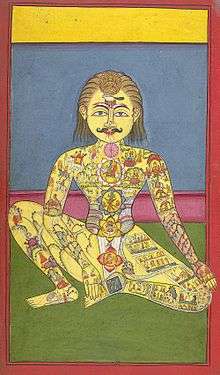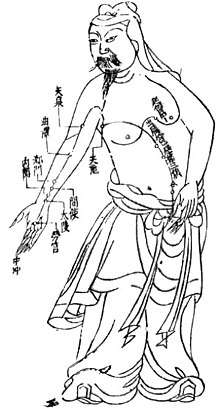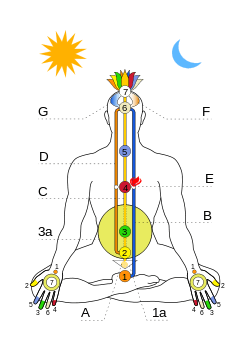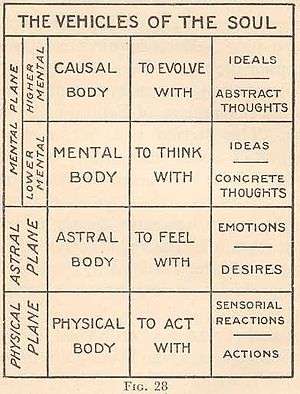Subtle body

A subtle body is one of a series of psycho-spiritual constituents of living beings, according to various esoteric, occult, and mystical teachings. According to such beliefs each subtle body corresponds to a subtle plane of existence, in a hierarchy or great chain of being that culminates in the physical form.
According to Bhagavad Gita, one of the most sacred texts of Hinduism, the subtle body is composed of mind, intelligence and ego, which controls the gross physical body.[1] It is also known in other different spiritual traditions: "the most sacred body" (wujud al-aqdas) and "true and genuine body" (jism asli haqiqi) in Sufism, "the diamond body" in Taoism and Vajrayana, "the light body" or "rainbow body" in Tibetan Buddhism, "the body of bliss" in Kriya Yoga, and "the immortal body" (soma athanaton) in Hermeticism.[2] The various attributes of the subtle body are frequently described in terms of often obscure symbolism: Tantra features references to the sun and moon as well as various Indian rivers and deities, while Taoist alchemy speaks of cauldrons and cinnabar fields.
History of the term
The expression "subtile body" appears suddenly in English literature in about 1650, appears erratically until it ceased to be used by about 1840. At that time, the more common term "subtle body" comes into use. The latter expression gradually gains in currency through the nineteenth century, and begins a sharp increase in usage from about 1940 until the present time.[3] Further research is needed to clarify the actual authors who used the phrase, and what they meant by it. But the word may have a connection with the Sanskrit Sūkṣma (subtle, unmanifest, dormant) Śarīra (body) which is described in the Vedas.[4]
Asian religions

The Yogic, Tantric and other systems of Hinduism, Vajrayana Buddhism, as well as Chinese Taoist alchemy contain theories of subtle physiology having a number of focal points (chakras, acupuncture points) connected by a series of channels (nadis, meridians) that convey subtle breath (prana, vayu, ch'i, ki, lung).
These invisible channels and points are understood to determine the characteristics of the visible physical form. By understanding and mastering the subtlest levels of reality one gains mastery over the physical realm. Through practice of various breathing and visualization exercises one is able to manipulate and direct the flow of vital force, to achieve supernormal powers (Sanskrit: siddhis) and attain higher states of consciousness, immortality, or liberation.
Hinduism

Early mentions of subtle body (Sanskrit: sūkṣma śarīra) concepts appear in the Upanishads, particularly the earliest known theory appears in the Taittiriya Upanishad's (circa 4th or 5th centuries BCE) theory of five bodies or selves.[5] The Taittiriya differentiates between five increasingly subtle body/selves: [5]
- The anna-maya ("food body", physical body/self),
- The prana-maya (body made of vital breath or prana),
- The mano-maya (body made of mind),
- The vijñana-maya (body made of consciousness)
- The ananda-maya (bliss body).
The Taittiriya also contains passages which suggests a theory of a subtle internal anatomy which includes the concept of a central channel (nadi).[5] In later Vedic texts called samhitas and brahmanas one also finds a theory of five "winds" or "breaths" (vayus, pranas):[6]
- Prāṇa, associated with inhalation
- Apāna, associated with exhalation
- Uḍāna, associated with distribution of breath within the body
- Samāna, associated with digestion
- Vyāna, associated with excretion of waste
A millennium later, these concepts were adapted and refined by various spiritual traditions. The similar concept of the Liṅga Śarīra is seen as the vehicle of consciousness in later Samkhya, Vedanta, and Yoga, and is propelled by past-life tendencies, or bhavas.[7] Linga can be translated as "characteristic mark" or "impermanence" and the term Sarira (Vedanta) as "form" or "mold".[8] Karana or "instrument" is a synonymous term. In the Classical Samkhya system of Isvarakrsna (ca. 4th century CE), the Lińga is the characteristic mark of the transmigrating entity. It consists of twenty-five tattvas from eternal consciousness down to the five organs of sense, five of activity (buddindriya or jñānendriya, and karmendriya respectively) and the five subtle elements that are the objects of sense (tanmatras) The Samkhyakarika says:
The subtle body (linga), previously arisen, unconfined, constant, inclusive of the great one (mahat) etc , through the subtle elements, not having enjoyment, transmigrates, (because of) being endowed with bhavas ("conditions" or "dispositions").
As a picture (does) not (exist) without a support, or as a shadow (does) not (exist) without a post and so forth; so too the instrument (linga or karana) does not exist without that which is specific (i.e. a subtle body).[9]
The classical Vedanta tradition developed the theory of the five bodies into the theory of the koshas "sheaths" or "coverings" which surround and obscure the self (atman). In classical Vedanta these are seen as obstacles to realization and traditions like Shankara's Advaita Vedanta had little interest in working with the subtle body.[10]
In Tantra traditions meanwhile (Shaiva Kaula and Buddhist yoga), the subtle body was seen in a more positive light, offering potential for yogic practices which could lead to liberation.[6] Tantric traditions contain the most complex theories of the subtle body, with sophisticated descriptions of energy nadis (literally "stream or river", channels through which vayu and prana flows) and chakras (lit. "circles") which are points of focus where nadis meet.[11] The main channels, shared by both Hindu and Buddhist systems, are the central (in Hindu systems: susumna; in Buddhist: avadhuti), left and right (in Hindu systems: ida and pingala; Buddhist: lalana and rasana).[12] Further subsidiary channels are said to radiate outwards from the chakras, where the main channels meet. There are various chakra systems depending on the tantra; the Netra tantra describes six chakras, the Kaulajñana-nirnaya describes eight, and the Kubjikamata Tantra describes seven (the most widely known set of chakras).[13]
In the 19th century, Indian subtle body terminology was adopted by the Theosophy of Madame Blavatsky.
The modern Indian spiritual teacher Meher Baba stated that the subtle body "is the vehicle of desires and vital forces,"[14] He held that the subtle body is one of three bodies with which the soul must cease to identify in order to realize God.[15]
Buddhism
.jpg)
In Buddhist Tantra, the subtle body is termed the ‘innate body’ (nija-deha) or the ‘uncommon means body’ (asadhdrana-upayadeha).[16] It is also called sūkṣma śarīra, rendered in Tibetan as traway-lu (transliterated phra ba’i lus). [17]
The subtle body consists of thousands of subtle energy channels (nadis), which are conduits for energies or "winds" (lung or prana) and converge at chakras.[16] According to Dagsay Tulku Rinpoche, there are three mains channels (nadis), central, left and right; "their beginning point is located between a person's eyebrows. From there, they run upward to the crown chakra. The passage then parallels the spine, running through all seven chakras - the centers of subtle energy - and ending about two inches below the belly button."[18]
Buddhist tantras generally describe four or five chakras in the shape of a lotus with varying petals. For example, the Hevajra Tantra (8th century) states:
In the Center [i.e. cakra] of Creation [at the sexual organ] a sixty-four petal lotus. In the Center of Essential Nature [at the heart] an eight petal lotus. In the Center of Enjoyment [at the throat] a sixteen petal lotus. In the Center of Great Bliss [at the top of the head] a thirty-two petal lotus.[19]
In contrast, the historically later Kalachakra tantra describes six chakras.[13]
In Vajrayana Buddhism, liberation is achieved through subtle body processes during Completion Stage practices such as the Six yogas of Naropa.[20]
Western esotericism
Theosophy
H. P. Blavatsky's Theosophical teaching represented the convergence of 19th century Western occultism, Eastern philosophy, religion, science, and mysticism. The Secret Doctrine, and The Key to Theosophy combined the Vedantic concept of five koshas with Western esoteric traditions (particularly Neoplatonism). She refers to three subtle bodies:
- Linga Sharira - the Double or Astral body
- Mayavi-rupa - the "Illusion-body"
- Causal Body - the vehicle of the higher Mind
The Linga Sharira is the invisible double of the human body, elsewhere referred to as the etheric body, doppelgänger or bioplasmic body and serves as a model or matrix of the physical body, which conforms to the shape, appearance and condition of his "double". The linga sarira can be separated or projected a limited distance from the body. When separated from the body it can be wounded by sharp objects. When it returns to the physical frame, the wound will be reflected in the physical counterpart, a phenomenon called "repercussion". At death, it is discarded together with the physical body and eventually disintegrates or decomposes.
The mayavi-rupa is dual in its functions, being: "the vehicle both of thought and of the animal passions and desires, drawing at one and the same time from the lowest terrestrial manas (mind) and Kama, the element of desire".[21]
The higher part of this body, containing the spiritual elements gathered during life, merges after death entirely into the causal body; while the lower part, containing the animal elements, forms the Kama-rupa, the source of "spooks" or apparitions of the dead.

Theosophy was further systematized in the writings of C.W. Leadbeater and Annie Besant. For example, they divided Blavatsky's dual mayavi-rupa into two different bodies: the emotional and the mental bodies. They also redefined some terms. The Linga Sarira (sometimes called astral body by Blavatsky) was denominated by Annie Besant[22] as Etheric double. C.W. Leadbeater, regarding the emotional body as the seat of the kamic principle of Blavatsky's constitution, denominated it astral body. Therefore, the subtle bodies in a human being are:
- Etheric body (vehicle of prana)
- Emotional or astral body (vehicle of desires and emotions)
- Mental body (vehicle of the concrete or lower mind)
- Causal body (vehicle of the abstract or higher mind)
Each "body" has its own aura and set of chakras, and corresponds to a particular plane of existence.

Post-theosophists
The later Theosophical arrangement was taken up by Alice Bailey, and from there found its way (with variations) into the New Age worldview. It is also associated with the human aura observed through Kirlian photography and Kilner screens. The anthroposophical view of the human being found in Rudolf Steiner's Anthroposophical teachings usually referred to only the Etheric and Astral Bodies. However, Steiner also used a threefold classification of body, soul, and spirit as well as a sevenfold and a ninefold description.
Max Heindel divided the subtle body into: Vital Body made of Ether, our instrument for specializing the vital energy of the sun, seen by clairvoyant vision to extend about an inch and a half outside the body; the Desire body, which is our emotional nature and pervades both the vital and dense bodies, seen by clairvoyant vision to extend about 16 inches outside our visible body, related to the Desire World; and the Mental body, which functions like a mirror, reflects the outer world and enables the Ego to transmit its commands as thought, word and action. The human being is seen as a threefold Spirit, possessing a Mind by which he governs the threefold Body that he transmutes into a threefold Soul. The Human Spirit aspect has emanated from itself the desire body to be transmuted into the Emotional Soul; the Life Spirit aspect has emanated from itself the vital body to be transmuted into the Intellectual Soul; the Divine Spirit aspect has emanated from itself the dense body to be transmuted into the Conscious Soul.
Samael Aun Weor wrote extensively on the subtle vehicles, organizing them in accordance with the kabbalistic Tree of Life. The common person only contains the lunar vehicles of emotion (astral body), thought (mental body), and will (causal body), concentrations of the collective animalistic intelligence, the evolution of the Essence through the mineral, plant and animal kingdoms. Becoming human means to have a soul, a Solar Astral Body, Solar Mental Body and Solar Causal Body. These bodies are constructed through a form of Tantra called White tantrism.[23]
Barbara Brennan's account of the subtle bodies in her books Hands of Light and Light Emerging refers to the subtle bodies as "layers" in the "Human Energy Field" or aura. Causality proceeds downwards: each of the layers has its own characteristics and can have its own expression of disease, requiring individual healing. As with the Adyar arrangement, each body or aura also has its own complement of chakras, which interrelate to those in the other layers.
Michal Levin describes the relationship between the energy bodies and the chakras in her book Meditation, Path to the Deepest Self.
Fourth Way
An interesting variant on the concept of subtle bodies is found in both Alchemical Taoism and the "Fourth Way" teachings of Gurdjieff and Ouspensky, where it is said that one can create a subtle body, and hence achieve post-mortem immortality, through spiritual or yogic exercises. The "soul" then is not something one is born with, but something that one has to develop through esoteric practice.
According to (Rosenthal, 1997) "In Gurdjieff's cosmology our nature is tripartite and is composed of the physical (planetary), emotional (astral) and mental (spiritual) bodies; in each person one of these three bodies ultimately achieves dominance." The Fourth way as taught by Gurdjieff and Ouspensky is a philosophy of developing the divine body which is gained when one has complete understanding and self perfection. The ultimate task of the fourth way teachings is to harmoniously develop the four bodies into a single way.[24]
Aleister Crowley and the Body of Light
The work of the Body of Light was part of English author and occultist Aleister Crowley's system of magick, saying in his Magick (Book 4) that it must be developed by rigid discipline, including rituals and the "assumption of god-forms", as well as by practice and experience.[25]
From Crowley's Magick Without Tears (Ch. 81):
One passes through the veil of the exterior world (which, as in Yoga, but in another sense, becomes "unreal" by comparison as one passes beyond) one creates a subtle body (instrument is a better term) called the body of Light; this one develops and controls; it gains new powers as one progresses, usually by means of what is called "initiation:" finally, one carries on almost one's whole life in this Body of Light, and achieves in its own way the mastery of the Universe.
See also
- Traditions
- Anthroposophy
- Hermeticism
- Neoplatonism
- Rosicrucianism
- Rosicrucian Fellowship ("Seven-fold constitution of Man" section)
- Rosicrucian Fellowship ("Ten-fold constitution of Man" section)
- Western Wisdom Teachings (philosophy)
- Spiritism
- Spiritual science
- Sufism
- Thelemic mysticism
- Theosophy
- Septenary (inspired by the five koshas of Vedanta)
Other topics
References
- ↑ pnd (15 July 2011). "Bg 13.6-7". www.vedabase.com. Archived from the original on 3 May 2018. Retrieved 3 May 2018.
- ↑ White.
- ↑ Google N-Gram. "N-Gram Analysis, "subtile body, subtle body"". Retrieved 17 March 2014.
- ↑ Three Bodies Doctrine (Vedanta)#Suksma sarira - subtle body
- 1 2 3 Geoffrey Samuel, Jay Johnston (editors). Religion and the Subtle Body in Asia and the West: Between Mind and Body, Routledge, 2013, p. 33.
- 1 2 Geoffrey Samuel, Jay Johnston (editors). Religion and the Subtle Body in Asia and the West: Between Mind and Body, Routledge, 2013, p. 34.
- ↑ Larson, Gerald. Classical Samkhya p.242
- ↑ Purucker, Gottfried. The Occult Glossary
- ↑ Samkhyakarika, transl. Gerald Larson, vv 60-81, Classical Samkhya p.268.
- ↑ Geoffrey Samuel, Jay Johnston (editors). Religion and the Subtle Body in Asia and the West: Between Mind and Body, Routledge, 2013, p. 34, 37
- ↑ Geoffrey Samuel, Jay Johnston (editors). Religion and the Subtle Body in Asia and the West: Between Mind and Body, Routledge, 2013, p. 38-39
- ↑ Geoffrey Samuel, Jay Johnston (editors). Religion and the Subtle Body in Asia and the West: Between Mind and Body, Routledge, 2013, p. 39
- 1 2 Geoffrey Samuel, Jay Johnston (editors). Religion and the Subtle Body in Asia and the West: Between Mind and Body, Routledge, 2013, p. 40
- ↑ Baba, Meher (1967). Discourses. 2. San Francisco: Sufism Reoriented. p. 145. ISBN 978-1880619094.
- ↑ Baba, Meher (1967). Discourses. 2. San Francisco: Sufism Reoriented. p. 144. ISBN 978-1880619094.
- 1 2 Wayman, Alex; Yoga of the Guhyasamajatantra: The arcane lore of forty verses : a Buddhist Tantra commentary, 1977, page 65.
- ↑ Lama Willa B Miller. Reviews: Investigating the Subtle Body. "Archived copy". Archived from the original on 19 March 2018. Retrieved 18 March 2018.
- ↑ Dagsay Tulku Rinpoche, The Practice of Tibetan Meditation: Exercises, Visualizations, and Mantras for Health and Well-being. Inner Traditions / Bear & Co, 2002, p. 80
- ↑ Geoffrey Samuel, Jay Johnston (editors). Religion and the Subtle Body in Asia and the West: Between Mind and Body, Routledge, 2013, p. 40.
- ↑ Geoffrey Samuel, Jay Johnston (editors). Religion and the Subtle Body in Asia and the West: Between Mind and Body, Routledge, 2013, p. 38.
- ↑ H. P. Blavatsky, "Astral Bodies, or Doppelgangers". Collected Writings X, pp. 217–220
- ↑ Annie Besant, The Ancient Wisdom, 1898.
- ↑ Samael Aun Weor. "Types of Spiritual Schools". Archived from the original on 31 May 2007. Note: The "ego" referred to by Samael Aun Weor is not used in the same context as it is used other esoteric schools.
- ↑ Bernice Glatzer Rosenthal The occult in Russian and Soviet culture 1997, p. 361
- ↑ Aleister Crowley Magick (Book 4), Samuel Weiser
Further reading
- Alfass, Mirra (The Mother) Mother's Agenda
- Besant, Annie, Man and His Bodies
- Brennan, Barbara Ann, Hands of Light : A Guide to Healing Through the Human Energy Field, Bantam Books, 1987
- —, Light Emerging: The Journey of Personal Healing, Bantam Books, 1993
- Mircea Eliade, Yoga: Immortality and Freedom; transl. by W.R. Trask, Princeton University Press, 1969
- C. W. Leadbeater, Man, Visible and Invisible
- Sheila Ostrander and Lynn Schroeder Psychic Discoveries Behind the Iron Curtain, Englewood Cliffs, New Jersey: Prentice Hall, 1970.
- Poortman, J. J. Vehicles of Consciousness; The Concept of Hylic Pluralism (Ochema), vol I-IV, The Theosophical Society in Netherlands, 1978
- Powell, Arthur E. The Astral Body and other Astral Phenomena
- —, The Causal Body and the Ego
- —, The Etheric Double
- —, The Mental Body
- Samael Aun Weor, The Perfect Matrimony or The Door to Enter into Initiation. Thelema Press. (1950) 2003.
- Samael Aun Weor, The Esoteric Course of Alchemical Kabbalah. Thelema Press. (1969) 2007.
- Steiner, Rudolf, Theosophy: An introduction to the supersensible knowledge of the world and the destination of man. London: Rudolf Steiner Press. (1904) 1970
- —, Occult science – An Outline. Trans. George and Mary Adams. London: Rudolf Steiner Press, 1909, 1969
- Heindel, Max, The Rosicrucian Mysteries (Chapter IV: The Constitution of Man: Vital Body - Desire Body - Mind), 1911, ISBN 0-911274-86-3
- Crowley, Aleister (1997). Magick (Book 4) 2nd ed. York Beach, Maine. : Samuel Weiser.
- Crowley, Aleister (1982). Magick Without Tears. Phoenix, AZ : Falcon Press
- Thelemapedia. (2004). Body of Light. Retrieved April 16, 2006.
- White, John. Enlightenment and the Body of Light in What is Enlightenment? magazine.
- James L. Oschman. Energy Medicine: The Scientific Basis.
- Levin, Michal. Meditation, Path to the Deepest Self, Dorling Kindersley, 2002. ISBN 978-0789483331
- Levin, Michal. Spiritual Intelligence: Awakening the Power of Your Spirituality and Intuition. Hodder & Stoughton, 2000. ISBN 978-0340733943
- Paramahansa Yogananda, Autobiography of a Yogi, Los Angeles, CA: Self-Realization Fellowship, 1946, Chapter 43.